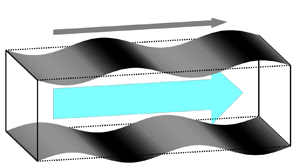Article contents
Large-eddy simulation of high-Reynolds-number turbulent channel flow controlled using streamwise travelling wave-like wall deformation for drag reduction
Published online by Cambridge University Press: 10 January 2025
Abstract

We investigate the drag reduction effect of the streamwise travelling wave-like wall deformation in a high-Reynolds-number turbulent channel flow by large-eddy simulation (LES). First, we assess the validity of subgrid-scale models in uncontrolled and controlled flows. For friction Reynolds numbers  $Re_\tau = 360$ and
$Re_\tau = 360$ and  $720$, the Smagorinsky and wall-adapting local eddy-viscosity (WALE) models with a damping function can reproduce well the mean velocity profile obtained by direct numerical simulation (DNS) in both the uncontrolled and controlled flows, leading to a small difference in drag reduction rate between LES and DNS. The LES with finer grid resolution can reproduce well the key structures observed in the DNS of the controlled flow. These results show that the high-fidelity LES is valid for appropriately predicting the drag reduction effect. In addition, a small computational domain is sufficient for reproducing the turbulence statistics, key structures and drag reduction rate obtained by DNS. Subsequently, to investigate the trend of drag reduction rate at higher Reynolds numbers, we utilize the WALE model with the damping function to investigate the control effect at higher Reynolds numbers up to
$720$, the Smagorinsky and wall-adapting local eddy-viscosity (WALE) models with a damping function can reproduce well the mean velocity profile obtained by direct numerical simulation (DNS) in both the uncontrolled and controlled flows, leading to a small difference in drag reduction rate between LES and DNS. The LES with finer grid resolution can reproduce well the key structures observed in the DNS of the controlled flow. These results show that the high-fidelity LES is valid for appropriately predicting the drag reduction effect. In addition, a small computational domain is sufficient for reproducing the turbulence statistics, key structures and drag reduction rate obtained by DNS. Subsequently, to investigate the trend of drag reduction rate at higher Reynolds numbers, we utilize the WALE model with the damping function to investigate the control effect at higher Reynolds numbers up to  $Re_\tau = 3240$. According to the analyses of turbulence statistics and instantaneous flow fields, the drag reduction at higher Reynolds numbers occurs basically through the same mechanism as that at lower Reynolds numbers. In addition, the drag reduction rate obtained by the present LES approaches that predicted using the semi-empirical formula (Nabae et al., Intl J. Heat Fluid Flow, vol. 82, 2020, 108550) as the friction Reynolds number increases, which supports the high predictability of the semi-empirical formula at significantly high Reynolds numbers.
$Re_\tau = 3240$. According to the analyses of turbulence statistics and instantaneous flow fields, the drag reduction at higher Reynolds numbers occurs basically through the same mechanism as that at lower Reynolds numbers. In addition, the drag reduction rate obtained by the present LES approaches that predicted using the semi-empirical formula (Nabae et al., Intl J. Heat Fluid Flow, vol. 82, 2020, 108550) as the friction Reynolds number increases, which supports the high predictability of the semi-empirical formula at significantly high Reynolds numbers.
Information
- Type
- JFM Papers
- Information
- Copyright
- © The Author(s), 2025. Published by Cambridge University Press
References
- 3
- Cited by


